Renewable Energy Transformer Market Research, 2032
The global renewable energy transformer market was valued at $29.9 billion in 2022, and is projected to reach $57.6 billion by 2032, growing at a CAGR of 7.1% from 2023 to 2032.
Report Key Highlighters:
- The renewable energy transformer market study covers 20 countries. The research includes a segment analysis of each country in terms of value ($Million) for the projected period 2023-2032.
- The study integrated high-quality data, professional opinions and analysis, and critical independent perspectives. The research approach is intended to provide a balanced view of global markets and to assist stakeholders in making educated decisions in order to achieve their most ambitious growth objectives.
- Over 3,700 product literature, annual reports, industry statements, and other comparable materials from major industry participants were reviewed to gain a better understanding of the market.
- The renewable energy transformer industry is highly fragmented, with several players including ABB, Acutran, Bharat Heavy Electricals Limited, CG Power and Industrial Solutions Ltd, DAIHEN Corporation, Eaton, Hammond Power Solutions, Hitachi, Ltd., Siemens, and STC, Incorporated.
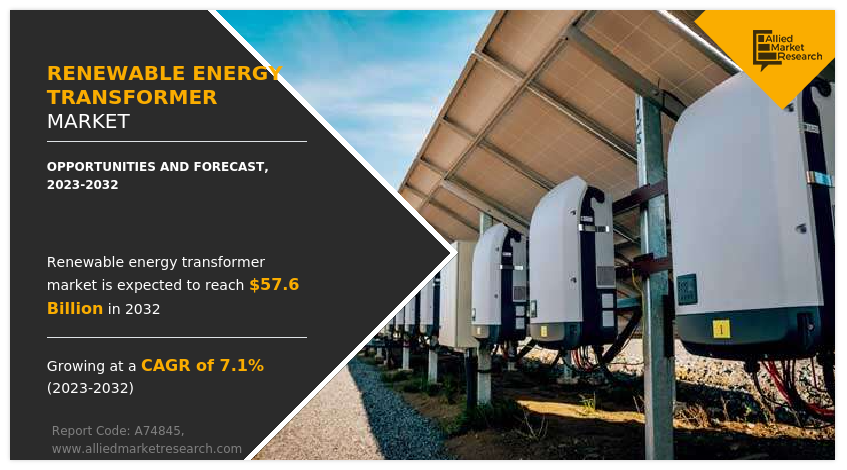
Renewable energy transformers refer to transformers designed specifically for use with renewable energy systems. The production, distribution, and integration of power from renewable energy sources such as wind, solar, hydropower, geothermal, and biomass depend extensively on these transformers.
Renewable energy transformers provide the electrical infrastructure needed to integrate renewable energy sources into the grid in a reliable and efficient manner. They address the growing demand for clean electricity while minimizing the carbon impact of power generation and play a vital role in promoting the transition to a more sustainable and environmentally friendly energy system.
The surge in demand for clean energy is poised to drive significant expansion in the renewable energy transformer market.
According to the International Renewable Energy Agency (IRENA), global renewable energy capacity increased by 9.6% in 2022. Transformers for renewable energy have grown necessary as the demand for green energy rises. These transformers provide less environmental impact, and enhance energy efficiency and renewable energy integration into the grid. Sustainable development and clean energy are essential components of the global energy landscape, and this development is expected to propel the market for renewable energy transformers.
Rise in public awareness of climate change and the need to reduce greenhouse gas emissions resulted in investments, rules, and incentives from the government to promote the growth of renewable energy projects. As a result, wind farms, solar power plants, and other green energy projects have proliferated. Transformers that are efficient and specifically designed are necessary to incorporate the energy produced by these renewable sources into the existing system. In addition, companies and industries are implementing green energy solutions to achieve sustainability goals and lower their carbon footprint.
Renewable energy transformers are essential to make sure that the electricity produced is effectively used or incorporated into the larger energy grid. With the development of renewable energy technologies and grid integration, individuals can produce their own renewable energy, such as rooftop solar panels. Transformers are necessary to link these distributed energy resources to the grid and control the two-way flow of power.
Moreover, demand for renewable energy transformer is fueled by increase in renewable energy installations in residential and commercial properties. Thus, rise in green energy boosts the growth of the renewable energy transformer market.
The high consumption of electricity is poised to be a significant driver for the renewable energy transformer market.
The rate of energy consumption in the commercial end-user industries including hospitals, healthcare, government and private organizations, educational institutions, transportation, storage facilities, department stores, and others is increasing daily with growing digitalization transformation, which is influencing the renewable energy transformers market demand. The electrical grid must be upgraded and expanded in response to this surge in demand. Transformers are essential for efficiently transmission power over long distances, as high electricity is required to fulfil the expanding demand, especially in urban areas and emerging markets. Consequently, there is rise in the need for transformers, particularly those made for renewable energy sources.
In addition, the variable and intermittent nature of energy generated from sources such as solar and wind power is specifically accommodated by renewable energy transformers. This makes them vital to maintain the dependability of the electrical supply, and allow for bidirectional power transmission, and maintain grid stability. Demand for renewable energy transformers has increased as the requirement for grid expansion and improvement grows along with the amount of electricity consumed.
The growth of renewable energy sources is driven by the global effort to cut greenhouse gas emissions and switch to more environmentally friendly energy sources. These transformers are necessary to increase voltage for long-distance transmission from renewable energy facilities to end customers. The demand for specialized transformers is driven by increase in requirement for efficient integration of renewable energy sources due to rise in power consumption. Thus, rise in usage of electricity boosts the growth of the renewable energy transformer market.
High initial investment retrains the renewable energy transformer market growth. Transformers for renewable energy are made to withstand variations in voltage demands, load profiles, and environmental circumstances of various renewable energy projects. Performance optimization requires customization, which is expected to increase production costs. In addition, transformers are expensive as they are frequently designed for efficiency, that involves reducing energy losses by utilizing advanced components and technology.
The size of a renewable energy project impacts the size and capacity of renewable energy transformers. Large-scale utility transformers with high capacity and voltage needs, such as those used in wind or solar farms, may be expensive and large. Moreover, high-grade components, including copper or aluminum windings, insulating materials, and magnetic cores, are needed to construct renewable energy transformers. These materials are often obtained at an excessive cost, especially for transformers that endure severe weather conditions.
Large transformer installation and transportation may be costly and logistically challenging, especially when it comes to remote renewable energy locations. It is frequently required to use specialized equipment for rigging and transporting. Furthermore, transformers used in renewable energy installations sometimes have low environmental effect designs. For instance, they might have to be built to endure harsh weather or sealed to stop oil leaks, both of which increase the cost of the product. Thus, the renewable energy transformer market size is constrained by high initial costs.
Environmental concerns have created significant growth opportunities for the renewable energy transformer market by driving the adoption of clean and sustainable energy sources. The necessity to switch from fossil fuels to renewable energy is increasingly being recognized as the globe deals with serious environmental problems including air pollution and climate change. Environmental concerns are driving this shift, which will have a significant impact on the renewable energy transformers market.
Demand for cleaner energy sources has increased due to environmental concerns, rise in public awareness, and rising activism. Communities, companies, and consumers are looking for various methods to reduce their influence on the environment. Distributed renewable energy systems, that depend on transformers for grid connection, are increasing in use owing to the demand to reduce environmental concerns. Furthermore, global action against climate change is essential, as shown by international agreements such as the Paris Agreement. There is pressure on signatory countries to reduce emissions and switch to clean energy sources. Transformers are essential to fulfil several tasks, one of which is a commitment to renewable energy.
In addition, several international agreements to cut greenhouse gas emissions resulted from concerns about climate change. Traditional energy sources that contribute significantly to these emissions include oil, natural gas, and coal. Transformers facilitate the transition to renewable energy sources, enabling power production with reduced carbon footprints. The market for renewable energy transformers increased due to the alignment with environmental concerns. Moreover, the use of fossil fuels damages the ecosystem and poses a health risk in addition to accelerating climate change. Regional and local air quality is improved by renewable energy, which is made possible by transformers. Thus, environmental issues present lucrative growth opportunities for the renewable energy transformer market.
The renewable energy transformer market is segmented on the basis of type, insulation, capacity, application, and region. On the basis of type, the market is classified into distribution transformers, power transformers, and others. By insulation, the market is bifurcated into dry and liquid immersed. Depending on capacity, the market is segregated into 5 MVA to 100 MVA, 100 MVA to 500 MVA, and 500 and above. By application, the market is classified into hydro energy, wind farm, solar PV, and others. Region-wise, the market is analyzed across North America, Europe, Asia-Pacific, and LAMEA.
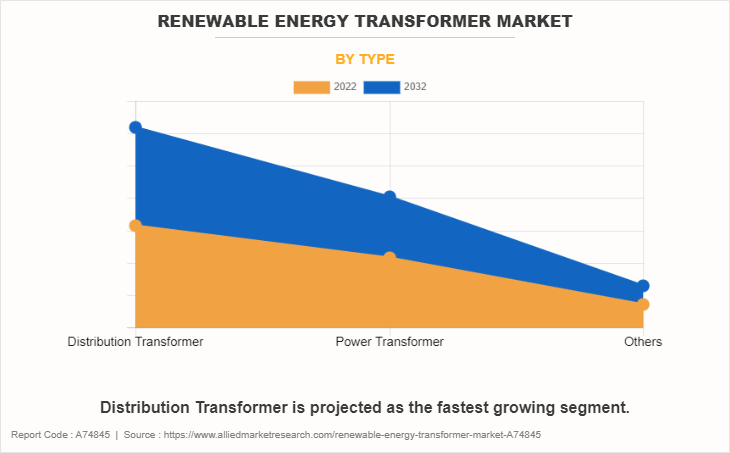
The distribution transformer segment accounted for the largest share in 2022 and is expected to register the highest CAGR of 7.4%. Distribution transformers dominate the renewable energy transformer market due to its vital role in stepping down voltage for efficient power distribution from renewable sources, facilitating seamless integration into existing networks, and allowing decentralized renewable energy systems. Their widespread utilization is primarily driven by the growing requirement for reliable electricity distribution and the development of smart grid infrastructure.
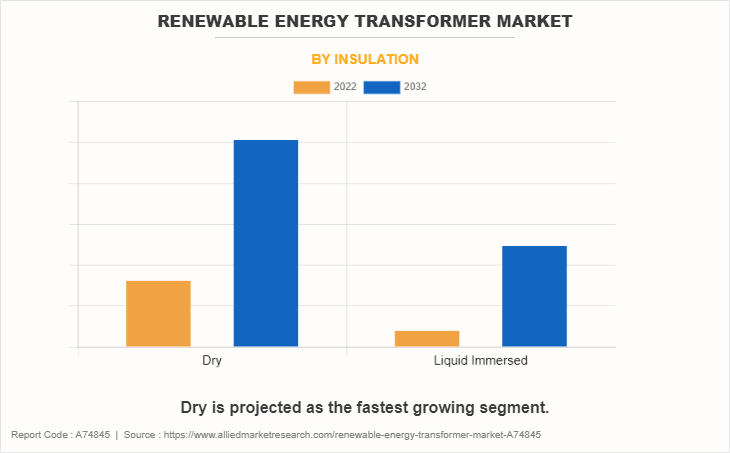
The dry segment accounted for the largest share in 2022 and is expected to register the highest CAGR. Dry insulation holds the largest share of the renewable energy transformer market as it is safer, less expensive to maintain, and more sustainable than traditional oil-filled transformers. Strict laws and a growing emphasis on environmentally friendly solutions are factors that drive the need for dry insulation in renewable energy applications.
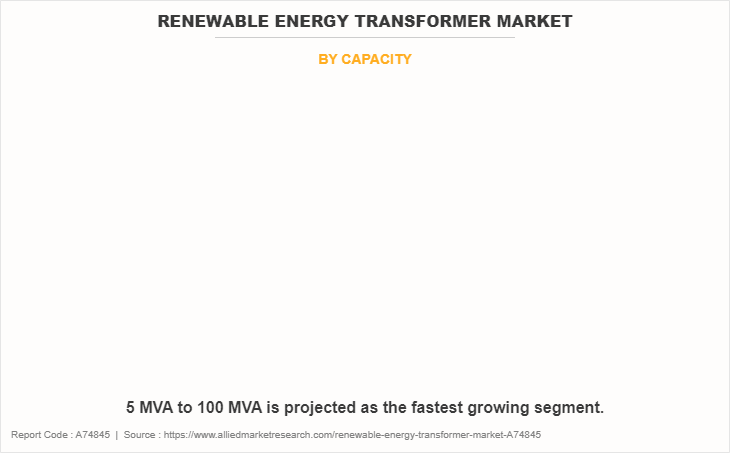
The 5 MVA to 100 MVA segment accounted for the largest share in 2022 and is expected to register the highest CAGR. The 5 MVA to 100 MVA capacity range has the largest share of the renewable energy transformer market due to its versatility in efficiently handling the electricity supplied by medium- to large-scale renewable energy projects. Within the renewable energy sector, this capacity range is preferred for effective power distribution as it complies with the growing trend of utility-scale solar and wind farms.
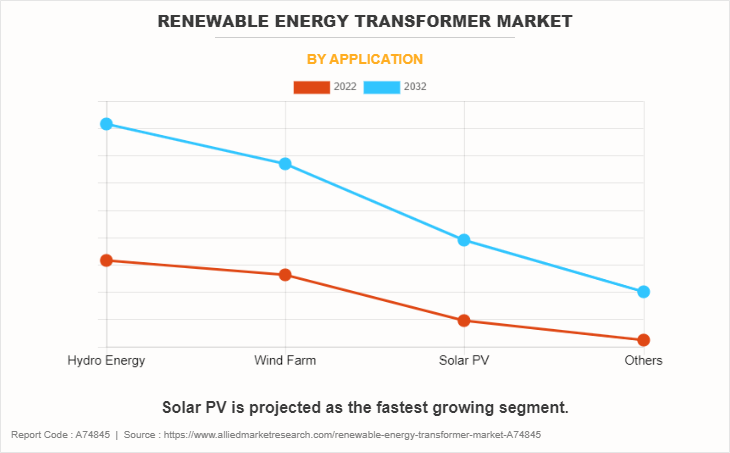
The Hydro Energy segment accounted for the largest share in 2022. Hydro energy possesses the largest market share for renewable energy transformers as it is extensively employed in large-scale hydroelectric power facilities and needs dependable transformers for efficient energy transmission. The dependability, scalability, and durability of these renewable energy sources have led to an increased need for transformers made expressly for hydroelectric power.
Solar PV is expected to register the highest CAGR of 7.6%. The demand for transformers specifically designed for solar power systems is driven by the rapid advancements in photovoltaic technology, rise in solar installations, and government incentives that promote the use of solar energy.
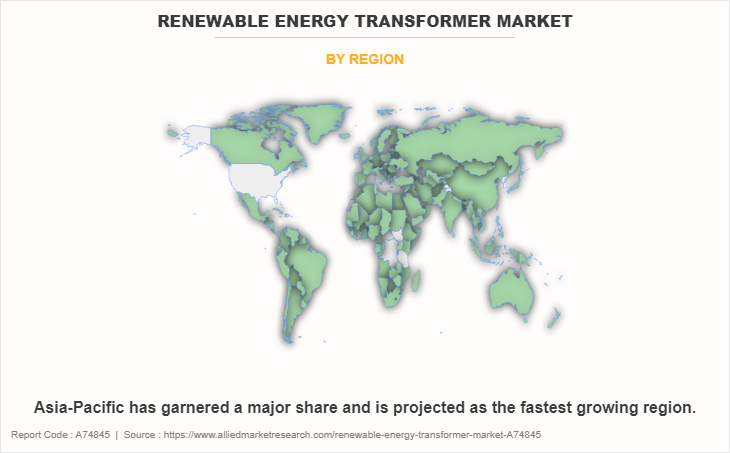
Asia-Pacific garnered the largest renewable energy transformer market share in 2022. The renewable energy transformer market is dominated by the Asia-Pacific region, mainly due to the significant investments made in countries like as China and India, that have resulted in a substantial rise in renewable energy capacity. Its dominance in the renewable energy transformer market is a result of government initiatives, the region's growing emphasis on sustainable energy sources, and its advantageous regulatory environment.
The major players operating in the global renewable energy transformer market are ABB, Acutran, Bharat Heavy Electricals Limited, CG Power and Industrial Solutions Ltd, DAIHEN Corporation, Eaton, Hammond Power Solutions, Hitachi, Ltd., Siemens, and STC, Incorporated.
Other players include Alstom SA, CAHORS, General Electric, POWERTRONIX INC., Prolec GE, Schneider Electric, SGB-SMIT POWER MATLA, Voltamp, WEG, and Wilson Transformers.
Strategic developments undertaken by key players
In October 2023, Eaton started construction on a USD 100 million expansion of its Nacogdoches, Texas manufacturing site. This project, which was announced in August, would increase Eaton's production capacity for three-phase transformers and voltage regulators to fulfil the growing demand from utilities for solutions that will speed up grid modernization. This expansion will boost the growth of the renewable energy transformer market.
In April 2023, Eaton completed the acquisition of a 49 percent stake in Jiangsu Ryan Electrical Co. Ltd. (Ryan), a manufacturer of power distribution and sub-transmission transformers in China. Ryan’s products are widely used in renewable energy, data center, utility and industrial markets. The combination of Ryan’s high-quality products and Eaton’s global distribution will enable Eaton to serve customers better in Asia Pacific and across the globe, leading to the growth of the market.
In August 2022, Hammond Power Solutions launched NMX-J-351-1-ANCE-2021 compliant low and medium voltage distribution transformers. This standard replaces NMX-J-351-1-ANCE-2016 and sets improved efficiency levels, general safety requirements, specifications, and test methodologies for LV and MV distribution transformers. It is expected that the modified efficiency levels will, in comparison to the current efficiency levels, minimize energy losses by an average of 13 percent for medium voltage dry-type transformers and 18 percent for low voltage dry-type transformers. These transformers are commonly used for industrial, commercial, and renewable energy applications both indoors and outdoors. This product launch will strengthen the product portfolio of renewable energy transformers leading to market growth.
In June 2021, Hitachi ABB Power Grids, which is acquired by Hitachi, Ltd., launched a range of transformer devices for offshore floating applications. These products are designed to withstand the hard offshore climate in addition to the physically demanding conditions found on floating buildings. The portfolio will allow it possible to effectively capture and incorporate considerably larger amounts of wind energy into the global energy grid, hence facilitating the shift to sustainable energy sources in the future. This product launch will boost the demand for renewable energy transformer market.
Public Policies
Renewable Energy Standards: Many governments establish Renewable Portfolio Standards (RPS) or Renewable Energy Standards (RES) that mandate a certain percentage of a region's energy to be generated from renewable sources. These standards create a growing demand for renewable energy transformers to connect and integrate renewable power into the electrical grid.
Feed-in Tariffs (FiTs): Feed-in tariffs are financial incentives offered to renewable energy producers, guaranteeing fixed payments for the electricity they generate. These incentives stimulate the deployment of renewable energy projects, driving the need for transformers to connect these systems to the grid.
International Agreements: International agreements and commitments, such as the Paris Agreement, can influence a country's renewable energy policies, driving the adoption of renewable energy technologies and related transformers.
Impact Of Russia Ukraine War On the Renewable Energy Transformer Market
The Russia-Ukraine war may potentially impact the renewable energy transformer market in several ways, though the extent of these effects will depend on several factors, including the duration and escalation of the conflict, regional dynamics, and global economic conditions.
Manufacturers of renewable energy transformers may experience delays in production and higher prices if the war disrupts supply networks for transformer components. Global sourcing is used to acquire many components required in the construction of transformers, and supply chain disruptions can impact both, availability and cost.
The Russia-Ukraine conflict may raise concerns about energy security, especially in Europe, which has been working to reduce its reliance on Russian fossil fuels. This could further drive interest in expanding renewable energy capacity, including the use of renewable energy transformers.
Geopolitical tensions can affect energy prices, including fossil fuels. Renewable energy can be more attractive during periods of energy price volatility, potentially spurring demand for renewable energy transformers.
Key Benefits For Stakeholders
- This report provides a quantitative analysis of the market segments, current trends, estimations, and dynamics of the renewable energy transformer market forecast analysis from 2022 to 2032 to identify the prevailing renewable energy transformer market opportunities.
- The renewable energy transformer market analysis is offered along with information related to key drivers, restraints, and opportunities.
- Porter's five forces analysis highlights the potency of buyers and suppliers to enable stakeholders make profit-oriented business decisions and strengthen their supplier-buyer network.
- In-depth analysis of the renewable energy transformer market segmentation assists to determine the prevailing market opportunities.
- Major countries in each region are mapped according to their revenue contribution to the global market.
- Market player positioning facilitates benchmarking and provides a clear understanding of the present position of the market players.
- The report includes the analysis of the regional as well as global renewable energy transformer market trends, key players, market segments, application areas, and market growth strategies.
Renewable Energy Transformer Market Report Highlights
| Aspects | Details |
| Market Size By 2032 | USD 57.6 billion |
| Growth Rate | CAGR of 7.1% |
| Forecast period | 2022 - 2032 |
| Report Pages | 250 |
| By Capacity |
|
| By Application |
|
| By Type |
|
| By Insulation |
|
| By Region |
|
| Key Market Players | Acutran, DAIHEN Corporation, Bharat Heavy Electricals Limited, ABB, STC, Incorporated, Eaton, Siemens, Hammond Power Solutions, CG Power and Industrial Solutions Ltd, Hitachi, Ltd. |
Analyst Review
According to the insights of the CXOs of leading companies, the renewable energy transformer market is witnessing a surge due to its indispensable role in addressing the demand for clean energy. The use of energy sources such as wind, solar, hydropower, geothermal, and biomass is crucial to its production and distribution. These transformers are responsible for regulating voltage levels to ensure that the electrical output from renewable sources complies with grid regulations and allows for effective transmission and distribution. They are vital elements in the process of using renewable energy for extensive use in a variety of areas, such as commercial, industrial, and residential settings.
Growing demand for clean energy, smart construction initiatives, and increased infrastructure are driving growth in the market for renewable energy transformers. A major factor is rising electricity consumption in the commercial, industrial, and household sectors. Technological developments and environmental awareness present opportunities, but there are also limitations, such as high starting expenses and land constraints that hinder market expansion.
The industry is characterized by a high number of new market entrants that seek to tap lucrative opportunities in the global market while existing players enter strategic collaborations to increase capacities and expand their reach into emerging markets. The acquisition, collaboration, and expansion activities in the industry have increased significantly over the past decade. Companies constantly seek to establish long-term contract agreements with trusted partners for sustainable business operations globally.
Hydro energy is the leading application of Renewable Energy Transformer Market.
Technological advancements in the manufacturing of transformers and environmental concerns are the upcoming trends of Renewable Energy Transformer Market in the world.
Asia-Pacific is the largest regional market for Renewable Energy Transformer.
ABB, Acutran, Bharat Heavy Electricals Limited, CG Power and Industrial Solutions Ltd, DAIHEN Corporation, Eaton, Hammond Power Solutions, Hitachi, Ltd., Siemens, and STC, Incorporated. are the top companies to hold the market share in Renewable Energy Transformer.
The global Renewable Energy Transformer Market is valued at $29.9 billion in 2022, and is projected to reach $57.6 billion by 2032, growing at a CAGR of 7.1% from 2023 to 2032.
Loading Table Of Content...
Loading Research Methodology...


